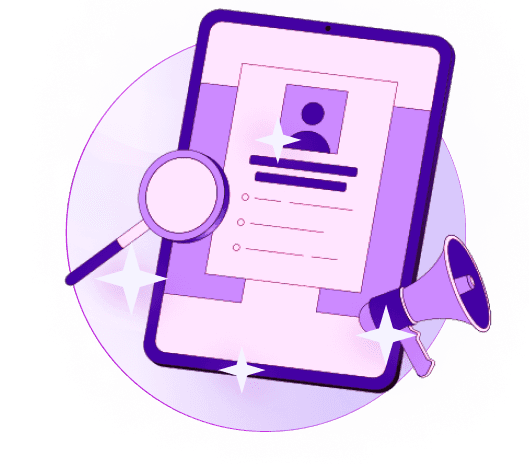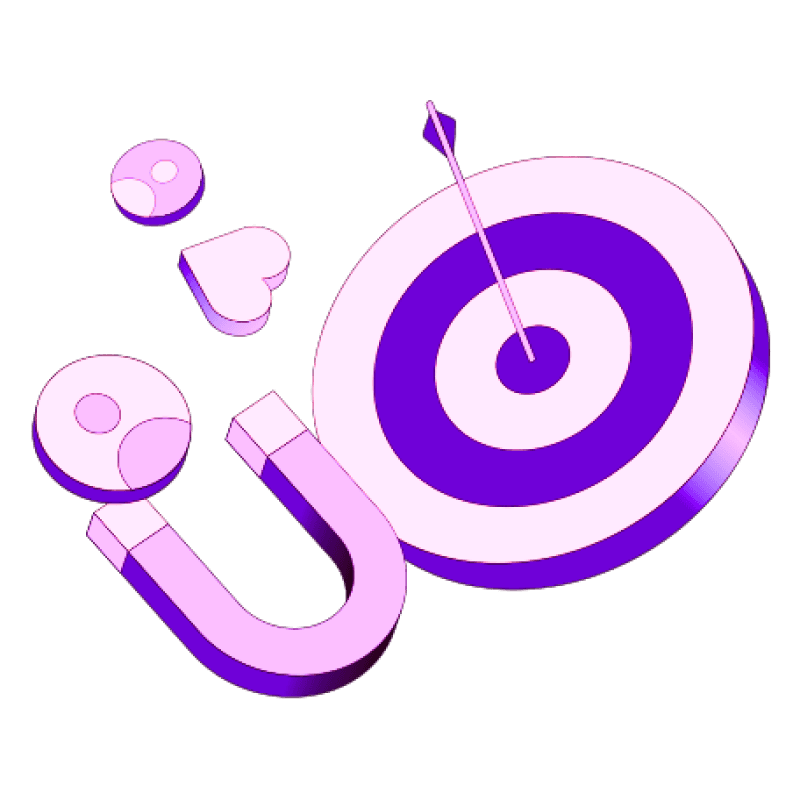Blogs
Articles

How to Create an Ideal Customer Profile for Effective Sales Prospecting
Companies with a clear ideal customer profile achieve 67% higher win rates. This stat speaks volumes.
Your sales efforts work better if you know exactly who you're selling to. Research shows 86% of business buyers are more likely to purchase when someone understands their goals.
Let me show you how to create an ideal customer profile that will change your sales prospecting efforts. You'll learn practical steps to identify, document and use your ICP to maximize sales success, whether you're just starting out or looking to improve your current approach.
What is an Ideal Customer Profile (ICP)?
An ideal customer profile (ICP) is the perfect company that would get the most value from your product or service. This isn't just a basic description. It's a detailed blueprint of businesses most likely to become your long-term, successful customers.
Your ICP has specific traits like company size, revenue thresholds, industry specifications, geographic considerations, and legal limitations that might affect their buying power. An effective ICP spots pain points your solution directly fixes and looks at budget limits or buying patterns that shape purchasing decisions.
Ideal customer profile vs buyer persona
People often mix up ideal customer profiles and buyer personas, but they play different roles in your sales strategy. The main difference shows up in their scope and focus.
Your ICP zeros in on finding the right companies, while buyer personas help you understand the people inside those companies. You can think of it this way: your ICP describes the company where your buyer persona works.
To cite an instance, if you sell fleet vehicles to hospitality businesses, your ICP might be hotel chains, while your buyer persona could be the operations manager who makes buying decisions.
Why ICP matters in B2B sales?
A well-defined ideal customer profile's effect on B2B sales is huge. Companies with strong ICPs see 68% higher win rates than those without them. About 71% of businesses that keep beating their revenue goals use ideal customer profiles as key parts of their sales and marketing processes.
Good sales performance isn't the only benefit. ICPs stop you from wasting money on bad-fit customers. Research shows companies with less than 10% of their customer base matching their ICP are 50% less likely to make it through the next five years.
Your ICP works as a qualification tool during prospecting. It helps you decide where to put your valuable resources, which guides you to more closed deals and happier customers.
How to define your ideal client profile?
Creating a successful ideal customer profile starts with a systematic plan. Let's take a closer look at six steps that will help you define your ideal clients accurately.
1. Analyze your best customers
Start by getting into your current customer base to spot those who bring the most value to your business. Search for customers with high customer lifetime value (CLV), quick sales cycles, low support costs, and great referral rates. Your goal is to spot customers who thrive with your product and give back through revenue, referrals, or testimonials. Your CRM data can reveal patterns among these top performers and show what makes them successful.
2. Identify common traits and firmographics
After you spot your best customers, search for their shared traits. The key firmographic data includes:
Industry or specialization
Company size and employee count
Geographic location
Technology stack
Growth stage
Funding status
These patterns will show what connects your most successful clients.
3. Understand customer pain points and goals
Your customer's challenges play a vital role in creating an effective ICP. Talk to your existing customers to learn about their needs, how they make decisions, and what they value most in your offering. Key questions to ask include:
What made them buy your product?
Which problems did they need to solve?
What are their "jobs to be done"?
Why did they pick your solution over others?
These conversations paint a detailed picture of your ideal customer.
4. Segment into best, good, and bad fit
Your customer data analysis helps create segments based on product or service fit. The best-fit customers show higher product engagement, stronger commercial metrics, need less support, and line up with your strategy and values. This grouping helps you focus resources on the most promising prospects.
5. Verify and document your ICP
Next, put your findings into a detailed profile. Your customer-facing teams—sales, marketing, customer success, and support—should review this document and share their thoughts. Their input helps refine your ICP to strike a chord across your organization. Note that an ICP needs regular updates as markets and your business change.
6. Use an ideal customer profile template
A good ICP template helps organize your insights in a structured way. You can create your own format, but templates ensure you capture everything important. Companies like Persana offer tools to streamline this process, making it easier to build and maintain customer profiles that boost your sales prospecting efforts.
Steps to Create an Ideal Customer Profile
A clear, methodical process helps you develop an effective ideal customer profile. The right steps will guide your efforts as you analyze data and document findings.
Your first task is to gather customer information from your CRM and other data sources. This data creates the foundation to identify patterns among your best customers. The process needs both quantitative and qualitative data to build a complete picture.
The next step identifies your "super users" who bring maximum value to your business. These customers share common traits like industry fit, buying power, and growth potential.
The patterns among these top performers need careful analysis. Your focus should include company size, geographic location, technology stack, and annual revenue. This analysis reveals who benefits most from your solution.
Your best customers' insights prove invaluable through interviews about their buying process, pain points, and product value. The right questions make a difference: "How did you first hear about our product?" and "What problem were you trying to solve?"
A simple template or spreadsheet helps document your findings. Note that an ICP needs regular updates based on new data and market changes.
Tools like Persana can simplify your ICP development process and create applicable profiles that boost sales prospecting success.
How to Use ICP for Sales Prospecting?
A well-implemented ideal customer profile can become your prospecting powerhouse. Companies that strictly follow their ICP see 68% higher win rates than those who don't.
Your ICP acts as a qualification filter that helps sales teams prioritize promising leads and reduce sales cycles. Rather than using broad approaches, you should target accounts that match your defined criteria.
Digital platforms like Facebook Ads and Google Ads help you reach audiences that fit your ICP characteristics. LinkedIn Sales Navigator's advanced filtering capabilities make it quick to find prospects matching your ideal profile.
Your current customer base is a goldmine of opportunities. Happy customers can connect you with similar businesses in their industry, which creates warm introductions to ICP-matched prospects.
Lead scoring based on your ICP criteria helps your team succeed. This strategy lets sales teams focus on the most promising leads. Companies that use customer insights perform 85% better in sales growth than their competitors.
Persana makes this process smoother by helping you organize and analyze your ICP data. The platform enables smarter sales prospecting through intelligent lead qualification and ranking.
What are the 4 types of customer personas?
Your ideal customer profile becomes clearer when you understand different customer personas and their buying patterns. B2B and B2C environments typically show four main types of customer personas.
Competitive personas want the best solutions and need solid proof of your advantages over competitors. These decisive customers need to see how your product fixes their problems fast. They turn into loyal promoters who bring quality referrals once they're convinced.
Spontaneous personas like to keep things quick and simple when making decisions. Their gut feeling guides their purchases rather than deep analysis. Quick solutions matter most to them, and they quickly jump on time-sensitive deals or special offers.
Humanistic personas build emotional bonds with your brand story and core values. Their buying choices stem from trust and relationships. These empathetic buyers value the team behind your business and look for real connections before they buy.
Methodical personas look at every single detail before they decide. They need detailed facts, documents, and proof to back your claims. These analytical customers do their homework thoroughly. While they take longer to convert, they often become your most steadfast clients after you win them over.
Conclusion
A well-crafted ideal customer profile ranks among the most powerful tools to boost sales prospecting. Companies using well-defined ICPs see 67% higher win rates - a statistic that definitely shows the value of knowing your best customers. Your ICP acts like a treasure map that guides your sales team toward prospects who could become loyal, long-term customers.
Your ICP's focus lies in identifying target companies, while buyer personas help understand decision-makers within these organizations. This difference matters by a lot when you develop your prospecting strategy. Your ICP should evolve with your business growth and market changes - it's a living document that needs regular updates.
Your ICP helps customize communication based on four customer types - competitive, spontaneous, humanistic, and methodical buyers each respond uniquely to sales approaches. These insights enable your team to tailor outreach efforts that work best.
A strong ICP strategy revolutionizes your prospecting efforts and entire sales operation. Many organizations struggle with this vital first step, yet those who become skilled at it outperform competitors in sales growth by 85%. The time you invest to develop, document, and update your ideal customer profile pays off. Your sales success depends on knowing who benefits most from your solution and why.
Key Takeaways
Creating an ideal customer profile is the foundation of successful sales prospecting, helping you focus on prospects most likely to convert and become loyal customers.
• Companies with clear ICPs achieve 67% higher win rates - specificity in targeting dramatically improves sales performance over casting wide nets.
• Follow the 6-step ICP process: analyze best customers, identify common traits, understand pain points, segment by fit, validate findings, and document everything.
• Use your ICP as a qualification filter to prioritize high-potential leads, with organizations using customer insights outperforming competitors by 85% in sales growth.
• Remember ICPs focus on companies, buyer personas focus on people - your ICP identifies target organizations while personas help understand decision-makers within them.
• Treat your ICP as a living document that requires regular updates as your business evolves and markets change to maintain prospecting effectiveness.

Create Your Free Persana Account Today
Join 5000+ GTM leaders who are using Persana for their outbound needs.
How Persana increases your sales results
One of the most effective ways to ensure sales cycle consistency is by using AI-driven automation. A solution like Persana, and its AI SDR - Nia, helps you streamline significant parts of your sales process, including prospecting, outreach personalization, and follow-up.



